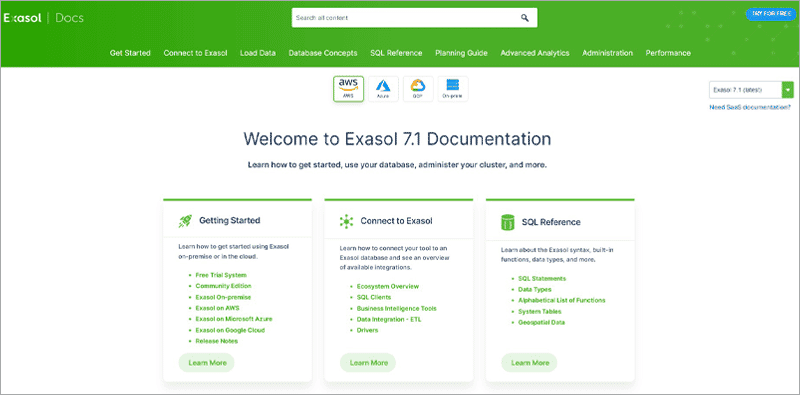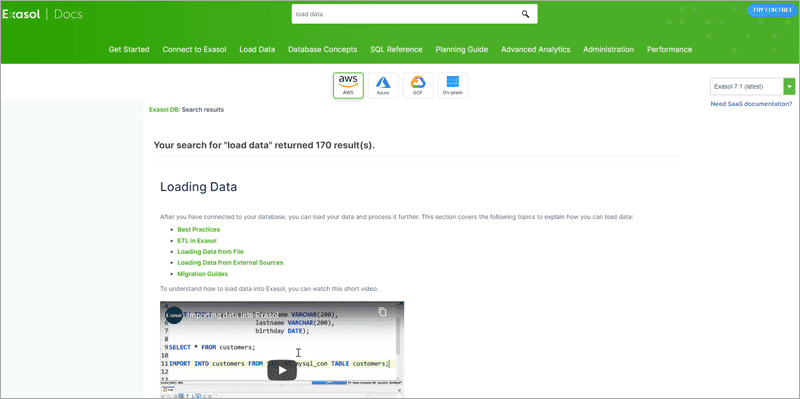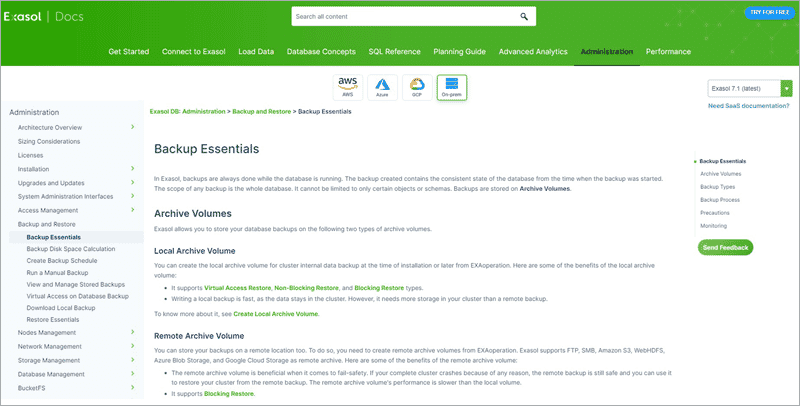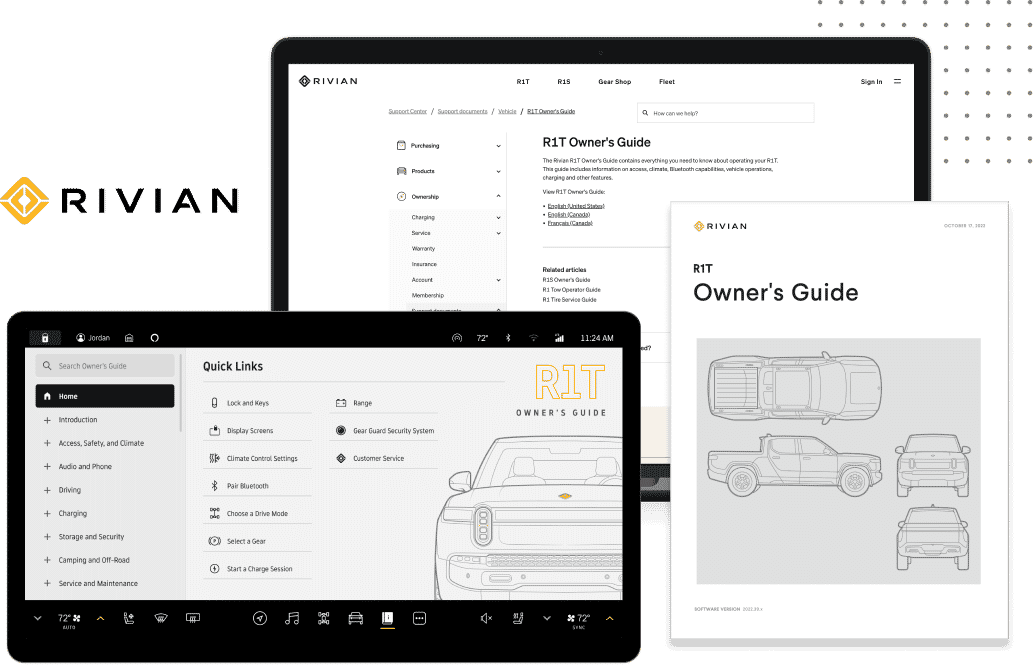Customer Success Story
Market-Leading High-Performance Analytics Database Company Exasol Uses MadCap Flare to Deliver Customized, Modern Web Experiences with its Documentation Portal
Goals
- Facilitate customer self-service and reduce demands on Exasol’s support and pre-sales teams.
- Create a modern web experience for documentation that matches the world-class experience of its Exasol SaaS and Exasol Database running on cloud platforms.
- Tailor content delivered to customers based on the product versions and infrastructure they use.
- Streamline the process of creating and updating content Exasol’s product documentation.
Benefits
- Reduced Support Demands: Micro content with both text and video, advanced search, and top and side navigation options in the MadCap Flare-based documentation portal help customers and Exasol support and pre-sales employees to quickly find the information they need.
- Modern Web Experience: Exasol takes advantage of responsive design, robust search, and multimedia support in MadCap Flare to deliver a world-class, interactive documentation website.
- Customized Content: Together conditions and snippets in MadCap Flare plus JavaScript-based logic present Exasol Database users with topics and search results specific to the product version and supporting infrastructure they use.
- Streamlined Content Creation: Topic-based authoring, single-source publishing, conditions and snippets in MadCap Flare enable the Exasol education team to maximize content reuse while shortening the time required to create and update content.
MadCap Software Solutions and Services:
Exasol is passionate about helping companies to run their businesses smarter and drive profits by analyzing data and information at unprecedented speeds. The company develops the world’s fastest high-performance analytics database for analytics and data warehousing and offers first-class know-how and expertise in data insight and analytics. Some 200-plus organizations, including some of the world’s best-known consumer brands, rely on Exasol to analyze their data in real time.
With a focus on providing world-class solutions and support, Exasol delivers a modern documentation website that lets customers easily navigate to information tailored for the product version and infrastructure platform they use, as well as get quick answers to their questions via micro content. To produce and maintain this web content, the company relies on MadCap Flare for content creation and publishing.
Building a World-Class Web Presence
In the past, Exasol’s documentation was generated off of the company’s software code and published as a 600-page PDF. Not only was the documentation difficult for customers to navigate; the lack of search limited Exasol’s online presence. Moreover, customers were increasingly moving their deployments to the cloud, and Exasol wanted to create online documentation that matched the modern experience of using its software on leading cloud platforms.
“We recognized that moving our documentation to an online searchable format was the first step in our journey to build a world-class web presence,” explained Nico Conforti, team lead, education at Exasol. “We then made the decision to go with MadCap Flare.”

The Exasol documentation portal home page offers easy accessibility to the company’s flagship Exasol Database software and their more recently launched Exasol SaaS (software-as-a-service) solution.
Today, visitors to the Exasol corporate website, simply click on the “Docs” tab to reach the documentation portal home page where they can choose between the company’s flagship Exasol Database software and more recently launched Exasol SaaS (software-as-a-service) solution. Users of both offerings then click to get to the landing page for their respective documentation. Like the corporate website, the Exasol documentation portal features a responsive design that adapts to any desktop or mobile screen.
Because Flare enables responsive design, we could create a documentation portal that gives customers a good experience on their mobile devices and at their desks.
Nico Conforti Head of Customer Enablement, Exasol AG
Four design elements of the documentation help to ensure users can quickly access the information they want: a horizontal top menu, vertical side menu on the left, drop-down list of topics on the right, and a search bar at the top.
“We try to give customers as much context as possible when they land on a page,” Nico noted. “With Flare, we’ve been able to create a portal that lets users find information in the way that works best for them, whether it is our top navigation, side navigation, topics list, or search.”
With Flare, we’ve been able to create a portal that lets users find information in the way that works best for them, whether it is our top navigation, side navigation, topics list, or search.
Nico Conforti Head of Customer Enablement, Exasol AG
Rich Search via Micro Content and Multimedia
Exasol has focused on creating a superior search experience, since most users come into the company’s site from a Google search and want the same ease of searching once they are in the documentation portal.
When users enter a term in the search bar, they not only get a list of relevant topics; in many cases, they also see micro content at the top, which provides a top-level answer and links to the most relevant topic with more detail. Created using MadCap Flare, the micro content allows many users to quickly get answers to the most common questions about Exasol.

Created using MadCap Flare, micro content allows many users to quickly get answers to the most common questions about Exasol.
“Since our product is a database, the frequently visited section is going to be about our SQL syntax, so we have used Flare to encapsulate almost all of our syntax in the micro content, and we’ve done the same thing with system tables,” Nico observes. “Using Flare’s micro content functionality is one more way that we are enhancing our search capabilities.”
Using Flare’s micro content functionality is one more way that we are enhancing our search capabilities.
Nico Conforti Head of Customer Enablement, Exasol AG
Notably, the Exasol team doesn’t limit micro content to text. They have started adding short videos into the micro content as well. The team embeds a YouTube no-cookie link into a MadCap Flare-based topic or piece of micro content and then wraps it in a <div> tag to ensure that the link does not break the formatting.
“It takes a little manual effort to make embedded YouTube links comply with EU laws, but with Flare we are able to create richer micro content that includes both text and videos,” Nico said.
Customized Navigation Based on a User’s Exasol Database Deployment
The Exasol SaaS functionality is the same for all users. By contrast, Exasol Database customers are using one of three supported product versions, and they are deploying the software with one of four supported infrastructure options: Amazon® Web Services® (AWS®), Microsoft® Azure®, Google® Cloud Platform® (GCP®), and on-premises.
For this reason, when customers go to the Exasol Database documentation, they see a dropdown menu to choose which product version they are using and four buttons for selecting the infrastructure they run on. Based on their selections, the documentation will present information specific to the user’s software version and infrastructure.
“One of Exasol's key value propositions is our flexibility, so we're available on all the big three cloud platforms: Google Cloud®, AWS® and Azure®, as well as an on-premises. This has impacted how we've structured our documentation,” Nico explained. “In line with how the same core software has different administration for each platform, we have a single Flare project and use snippets and conditions to display the right content based on the customer’s choice.”
Uniquely, Exasol’s documentation portal goes beyond version selection and directs users to the correct topics based on their choices. For example, if a customer selects AWS® as the cloud platform, this user will see the homepage updated to show AWS®-related topics because of the MadCap Flare conditions applied. Then, this choice is remembered anytime the user comes back to the documentation portal from the same computer. So, the home page will once again show AWS®-related topics, and searches will automatically provide responses relevant to AWS® deployments. The Exasol team created this functionality by combining MadCap Flare conditions with logic built in JavaScript.
“We created the customized views of our documentation by combining MadCap Flare conditions with logic we built in JavaScript,” Nico explained. “Without the open, industry-standard architecture of Flare, adding custom JavaScript to create individualized experiences for our customers simply would not have been possible. The flexibility to go through the Flare UI or add custom JavaScript opens up the possibilities to do really cool things.”
Without the open, industry-standard architecture of Flare, adding custom JavaScript to create individualized experiences for our customers simply would not have been possible.
Nico Conforti Head of Customer Enablement, Exasol AG
Maximizing Team Efficiency
Behind all the customized views that customers see is a single Flare project with a table of contents (TOC). In addition to snippets and contents within the topics, the Exasol team also has put conditions in the TOC—maximizing content reuse and cutting project time.
“Single-sourcing with Flare means that I can update any page once, and the change will be applied everywhere. If I find a typo, I don't have to update it in 12 different places,” Nico said. “The combined use of single-sourcing and conditions in Flare also lets us create content in advance and then simply use conditions to publish it once the product goes live.”

The Exasol team uses conditions in their project table of contents (TOC) to maximize content reuse and cut project time when creating new topics.
While the education team at Exasol has been able to cost-effectively create and publish the MadCap Flare-based documentation portal, many of their colleagues have also gained efficiencies from using the portal.
“My co-workers in support or in pre-sales are saying it's much easier for them to find the information they need in our Flare-based documentation portal. And in support, it's not uncommon to provide the customer a one-sentence reply saying, ‘Please see this page’,” Nico says. “Since introducing the Flare-based portal our experiences have been quite positive all around.”
My co-workers in support or in pre-sales are saying it's much easier for them to find the information they need in our Flare-based documentation portal.
Nico Conforti Head of Customer Enablement, Exasol AG





